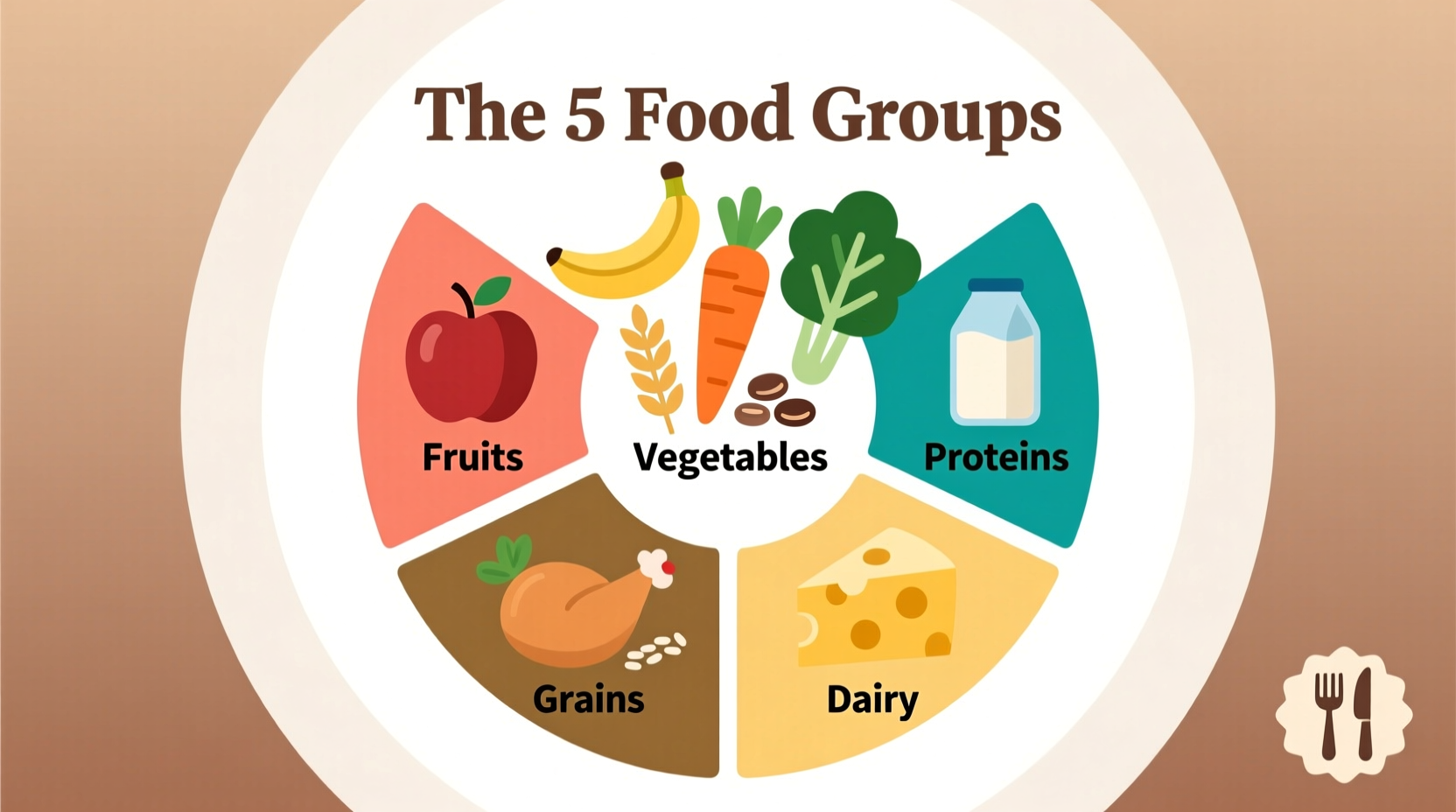Understanding the five food groups transforms how you approach meal planning and nutrition. Whether you're managing dietary goals, teaching children healthy habits, or simply seeking to improve your daily eating patterns, this framework provides practical structure for building balanced meals that support long-term health and wellness.
Why Food Groups Matter for Your Health
Food groups aren't arbitrary categories—they represent scientifically determined nutritional building blocks essential for optimal health. The current food group system evolved from decades of nutritional research, replacing earlier pyramid models with the more intuitive MyPlate visual guide in 2011. Each group delivers specific nutrients your body needs in proper proportions, creating synergy when consumed together throughout the day.
Your Complete Guide to the Five Essential Food Groups
Fruits: Nature's Sweet Nutritional Powerhouses
Fruits provide essential vitamins, minerals, fiber, and antioxidants with naturally occurring sugars. Unlike processed sweets, whole fruits deliver these nutrients alongside fiber that regulates sugar absorption. The Dietary Guidelines for Americans recommend filling half your plate with fruits and vegetables at each meal, emphasizing variety for maximum nutritional benefit.
Top fruit choices: Berries, citrus fruits, apples, bananas, and melons. While 100% fruit juice counts toward your fruit intake, whole fruits provide additional fiber and are generally preferred for most meals.
Vegetables: The Colorful Foundation of Healthy Eating
Vegetables offer diverse nutritional profiles across five subgroups: dark green, red and orange, beans and peas (also counted as proteins), starchy, and others. This diversity explains why nutrition experts emphasize "eating the rainbow"—different colors indicate different phytonutrients that support various bodily functions.
According to the 2020-2025 Dietary Guidelines for Americans, adults should consume 2-3 cups of vegetables daily, with specific recommendations varying by age, sex, and activity level. Frozen and canned vegetables (without added salt or sugar) count equally toward your daily goals when fresh options aren't available.
| Food Group | Daily Recommendation (Adults) | Key Nutrients |
|---|---|---|
| Fruits | 1.5-2 cups | Vitamin C, potassium, fiber |
| Vegetables | 2-3 cups | Vitamins A & K, folate, fiber |
| Grains | 5-8 ounce-equivalents | B vitamins, iron, fiber |
| Protein Foods | 5-6.5 ounce-equivalents | Protein, iron, zinc, B vitamins |
| Dairy | 3 cups | Calcium, vitamin D, potassium |
Grains: Energy Providers with Important Distinctions
Grains fall into two categories: whole grains (containing all parts of the grain kernel) and refined grains (with parts removed during processing). The distinction matters significantly for nutrition—whole grains retain fiber, B vitamins, and other nutrients stripped from refined grains.
The USDA recommends making at least half your grains whole grains. Excellent choices include oats, quinoa, brown rice, and 100% whole wheat bread. Refined grains like white rice and regular pasta still count toward your grain intake but offer fewer nutritional benefits unless enriched.

Protein Foods: More Than Just Meat
This diverse group includes not only animal proteins but also plant-based options like beans, lentils, nuts, and seeds. The versatility matters for dietary flexibility—whether you're following a Mediterranean pattern, vegetarian diet, or traditional omnivorous eating.
According to the USDA Food and Nutrition Information Center, protein foods provide essential amino acids plus important nutrients like iron, zinc, and B vitamins. Seafood should appear at least twice weekly for omega-3 fatty acids, while plant proteins offer additional fiber benefits.
Dairy: Calcium-Rich Options Beyond Milk
The dairy group encompasses milk, yogurt, cheese, and fortified soy alternatives. These foods deliver calcium, potassium, vitamin D, and protein critical for bone health throughout life. For those with lactose intolerance or dairy allergies, fortified plant-based alternatives count when they provide equivalent nutrients.
The FDA recognizes fortified soy beverages as part of the dairy group due to their similar nutrient profiles, while other plant-based milks typically don't qualify unless specifically fortified to match dairy's nutritional composition.
Putting Food Groups Into Practice: Your Daily Nutrition Blueprint
Translating food groups into daily meals requires understanding both portions and combinations. The MyPlate visual divides your plate into sections: half for fruits and vegetables, one-quarter for grains, and one-quarter for protein, with dairy as a side portion.
Building Balanced Meals Across Different Dietary Patterns
Food groups adapt to various eating patterns:
- Vegetarian diets: Beans and peas serve double duty in both protein and vegetable groups
- Mediterranean approach: Emphasizes plant-based proteins and whole grains
- Allergy considerations: Nutrient equivalents maintain balance when avoiding specific foods
Common Food Group Misconceptions Clarified
Several myths persist about food groups that can undermine healthy eating:
- Myth: All carbs are bad Truth: Whole grains provide essential nutrients and fiber
- Myth: Fruit sugar is as problematic as added sugar Truth: Whole fruits deliver sugar with fiber and nutrients
- Myth: Plant proteins are incomplete Truth: Varied plant protein sources throughout the day provide all essential amino acids
How Food Group Recommendations Have Evolved
Nutritional guidance has transformed significantly over the past century:
- 1940s: Basic Seven food groups emphasized butter and fortified foods during wartime shortages
- 1950s-1970s: Basic Four (milk, meat, fruits/vegetables, bread/cereal) became standard
- 1992: Food Guide Pyramid introduced vertical sections representing proportions
- 2005: MyPyramid offered personalized recommendations but proved confusing
- 2011: Current MyPlate model launched with simple plate visualization
- 2020: Added emphasis on healthy eating patterns rather than isolated nutrients
This evolution reflects growing understanding that food synergy—how nutrients work together in whole foods—matters more than individual nutrient counting.
Special Considerations for Different Life Stages
Food group proportions adjust across the lifespan:
- Children: Higher dairy needs for bone development, smaller portion sizes
- Pregnancy: Increased protein and iron requirements, special attention to food safety
- Older adults: Higher protein needs to combat muscle loss, increased calcium and vitamin D
Cultural food traditions often align well with food group principles—Mediterranean, Asian, and Latin American cuisines naturally incorporate diverse foods across all groups through traditional meal patterns.
Frequently Asked Questions About Food Groups
What counts as a serving in each food group?
A serving varies by food group: 1 cup of leafy greens or ½ cup chopped vegetables equals one vegetable serving; 1 small fruit or ½ cup chopped fruit counts as one fruit serving; 1 ounce of grains equals one slice of bread or ½ cup cooked rice; 1 ounce of protein equals one egg or ¼ cup cooked beans; 1 cup of milk or yogurt equals one dairy serving.
Do beans and peas belong to both protein and vegetable groups?
Yes, beans and peas (including lentils, chickpeas, black beans, and kidney beans) count in both the protein foods group and the vegetable group. When planning meals, you can choose to count them toward either group based on your dietary pattern and nutritional goals for that meal.
How do food groups differ from food categories?
Food groups are scientifically defined categories based on nutritional composition and health benefits, while food categories might group items by preparation method, cultural tradition, or other non-nutritional characteristics. The five food groups specifically guide balanced eating patterns, whereas categories like "snacks" or "breakfast foods" don't provide the same nutritional framework.
Can I follow the food groups if I have dietary restrictions?
Absolutely. The food group system accommodates various dietary needs through substitution principles. For example, lactose-intolerant individuals can use fortified soy beverages in the dairy group; vegetarians count beans and lentils in the protein group; gluten-free eaters choose appropriate grains like rice and quinoa. The framework provides flexibility while maintaining nutritional balance.











 浙公网安备
33010002000092号
浙公网安备
33010002000092号 浙B2-20120091-4
浙B2-20120091-4